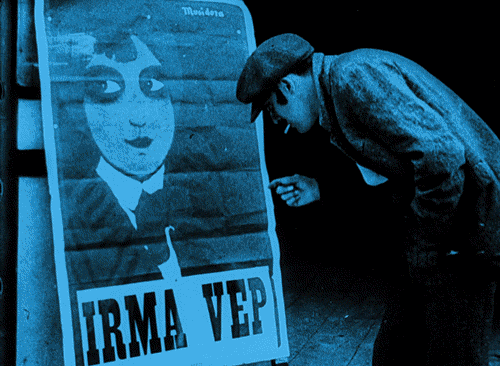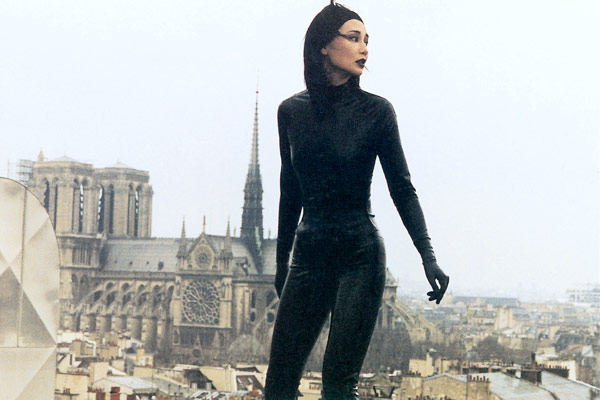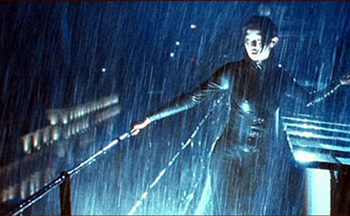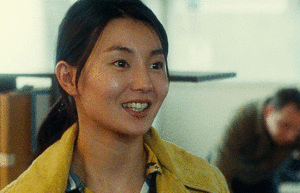From the June 13, 1997 Chicago Reader. July 17, 2022: I’ve just belatedly caught up with the first six episodes of Assayas’s Irma Vep miniseries, and even though it’s much lighter fare than the feature, I’m fascinated by the way he mixes in autobiographical and/or pseudo-autobiographical elements in this remake of a remake. — J.R.
Irma Vep
Rating ****
Directed and written by Olivier Assayas
With Maggie Cheung, Nathalie Richard, jean-Pierre Léaud, Lou Castel, Dominique Faysse, Bulle Ogier, Arsineé Khanjian, and Antoine Basler.
The whole point is that the world is constantly changing, and that as an artist one must always invent new devices, new tools, to describe new feelings, new situations….If we don’t invent our own values, our own syntax, we will fail at describing our own world. — Olivier Assayas, in a letter to critic Kent Jones
Like many other eras, ours is not inordinately fond of examining itself, and any movie that does that work for us risks being overlooked, resented, or simply misunderstood. Hou Hsiao-hsien’s Taiwanese Goodbye, South, Goodbye, one of the major films at Cannes last year to perform this task, was greeted mainly by bored puzzlement. But a Peruvian film critic in Chicago a few weeks back mentioned to me that this movie told him more about what was happening in contemporary Peru than any other he’d seen — which suggests that our awareness of global capitalism’s recent activities may be more germane to appreciating certain movies than their particular nationalities.
National identity can often obscure what certain films are saying, however, especially on the film’s home turf. Take Jim Jarmusch’s American movie Dead Man, which premiered at Cannes in 1995 and did pretty well globally, both critically and commercially, before straggling into this country a year later, where it was widely written off. Or consider Olivier Assayas’s French movie Irma Vep, another exciting state-of-the-planet address, which I saw at Cannes in 1996: it did terrible business in France the following fall but enjoyed an unexpectedly brisk box office at New York’s Film Forum last month, where it’s already been held over several weeks. Creepy and hip, fast moving and provocative, occasionally quite funny, and adept in its uses of pop music, Irma Vep has a good many calling cards, though disagreements are likely to start as soon as one has to consider what it’s about.
This week the Film Center is showing Irma Vep no fewer than 11 times, in a limited run, so you’ll have a chance to make up your own mind. You may decide that this dark, brittle, disturbing comedy about low-budget French filmmaking doesn’t say anything about the capitalist world right now — and I don’t mean to suggest that you won’t be able to enjoy the movie on a more modest level. Indeed, if you know as little about French cinema as David Denby, you might arrive at a conclusion comparable to his in his recent rave review in New York magazine (so positive it was reproduced in its entirety by the distributor): “The French have a great culture, a great history, but they are in a state of futility. A filmmaking industry that was both artistically innovative and financially resourceful now lies in ruins, destroyed by vanity, inconsequence, and the philistine exuberance of American entertainment, which both enrages the French and leaves them sick with envy: They can’t make our movies, and increasingly they can’t make their own….Irma Vep may be a bitter lament over a dead art form, but the movie itself is an extraordinary sign of life.”
I can’t imagine what sort of French people Denby hangs out with, because this cosmic description of “the French” excludes virtually every French filmmaker, critic, and filmgoer I know — many of whom are even more delighted by “the philistine exuberance of American entertainment” than Denby is. (When I was in Paris last month, Everyone Says I Love You was playing everywhere.) But from Denby’s comments I can easily infer what French movies he doesn’t see: the industry he finds in ruins last year produced, along with many other commercial successes, When the Cat’s Away, Encore, Le garcu, Ninette and Boni, Thieves, and Three Lives and Only One Death — to cite only the first few titles that come to mind. On the other hand, if you ignore French cinema as studiously as Denby does — and this isn’t only a matter of not attending festivals like Cannes — any sort of self-validating generalization will make sense. Many of his most prestigious New York colleagues see only one or two movies a day at Cannes — like the alienated laborer [Janet Maslin] who gets driven around in a limo paid for by Miramax, and who this year happily missed the Abbas Kiarostami film that shared the Palme d’Or — and write back to their readers with the same breezy, confident expertise about the moribund state of world cinema, usually concluding that the parties were better than the movies. (And no wonder — the parties speak their kind of language, the movies don’t.)
But if the Denbys, the Janet Maslins, and the Anthony Lanes are supposed to be our urbane guides to the state of world cinema, Irma Vep is at best only one example of the sort of films that elude their grasp. Despite Denby’s pronouncements, this is a movie that could be taking place almost anywhere in the world. Most of the dialogue is in English, and though the film within the film happens to be a remake of a silent French classic — Louis Feuillade’s glorious 1916 serial Les vampires — the behavior and attitudes in Irma Vep have more to do with 1996 filmmaking in general and what this says about the world than they do with French filmmaking at any time and what this says about “the French.”
On the other hand, French people are every bit as capable of misreading the film in relation to its nationality as New York “experts,” as if it were exclusively about French people. But Denby has at least half a point when he says, “I don’t see how any French person could see this movie without wincing: Assayas seems to be getting at widely shared character flaws — egotism and vanity as well as intellectual pretension substituting for creativity.” In other words, the nerve that Assayas hits is more likely to alienate French viewers, just as the nerve hit by Dead Man was more likely to alienate Americans. Still, I think what Irma Vep is saying about the world in general and filmmaking in particular concerns us all.
“Irma Vep,” the title of the film within the film, is the head villainess in Les vampires, her name an anagram of “vampire,” who rules a gang of thieves who prey exclusively on the rich. Played in the original serial by Musidora — a deft, dark-haired stage and music-hall performer who did all her own stunt work and whose plumpness, like that of Theda Bara, virtually defined female beauty in the teens — the character is identified mainly by the black tights and black mask she wears when slinking down corridors and fleetly escaping over rooftops. (Her costume — and much more in Les vampires — inspired the look of such later fantasy-adventures as The Phantom and Batman.)
Part of the exquisite magic of Les vampires today, apparent in the clips included in Irma Vep, is its comprehensive grasp of what Paris and Parisians looked like in the teens — an era that now appears closer to the 19th century than to the 20th. Another part of its magic, cherished by the early Surrealists, resides in the mysterious intrigues and hidden networks lurking behind its everyday settings, personified but not entirely exhausted by Irma and her band of coconspirators. Though she’s killed at the end of Les vampires, her gang survives in Nice in Feuillade’s sublime 1918 sequel Tih Minh, where it conspires to avenge her death and take over the entire world.
Though the sexiness of both serials is tied to the group’s secret machinations, Musidora’s plucky Vep gives them a particular spin: not only has she remained a fetish object for several generations of intellectuals and cinephiles, but French feminists called their first film event the Musidora Film Festival. The serials’ appeal also has to do with their improvisation on a day-to-day basis, virtually while they were being shot, creating dreamlike undercurrents. Clearly a similar effect is at work in Irma Vep: scripted in ten days and shot in less than a month, the film unravels like a delirious piece of automatic writing, though in this case the sinister implications apply to a very different world — our own.
What does it mean, in fact, to try to remake Les vampires 80 years later? For every character in Irma Vep, both male and female — virtually all of them part of the workaholic atmosphere of a film shoot, and thereby part of the same capitalist treadmill affecting most of us — it has something to do with libido and the sexual fantasies unleashed by that aggressive energy.
The fantasies are set in motion by the actress taking the Musidora part: Maggie Cheung, the real-life star of Hong Kong cinema, playing herself. The lure of third-world exoticism may seem relatively extraneous to Les vampires, but it functions centrally in Tih Minh, where the title heroine is Vietnamese. Though Cheung is as slender as Musidora was voluptuous (in keeping with 90s fashion) and speaks not a word of French, she’s cast by middle-aged French director Rene Vidal (Jean-Pierre Leaud) after he sees one of her action pictures in Marrakech. Arriving in Paris from Hong Kong at the beginning of Irma Vep, she’s taken directly to Vidal, who shows her the clip from The Heroic Trio (1993) that won him over, expressing admiration for the grace of her stunt work; when she points out that her stunt work was done by a double, the admission makes no dent in his enthusiasm.
Cheung’s main escort in Paris is Zoe (Nathalie Richard), who’s handling the costumes on Vidal’s picture. She promptly gets Cheung fitted in a tight latex suit from a sex shop. As smitten with Cheung as Vidal is, Zoe wryly notes that the still Vidal offers as a guide to how the actress should look — Michelle Pfeiffer’s Catwoman — makes her resemble a hooker, but this doesn’t stop Zoe from fixating on Maggie in the latex suit herself. At a dinner party later, she confides her lustful feelings to the hostess (Bulle Ogier); the hostess, armed with this confession, mortifies Zoe by asking Maggie if she likes girls, then telling her about Zoe’s secret desires.
This daisy chain of solipsistic desire and leering innuendo — in which no one listens to anyone else, or listens only in order to advance his or her position or to betray someone later — courses through the remainder of the movie like an electrical current, accumulating more bad vibes en route and tarnishing everyone but Cheung. Assayas records this feverish process in compulsive, twitchy camera movements as restless and neurotic as the characters, refusing to distance himself stylistically from this behavior, allowing it to turn his attention and ours as relentlessly as a series of tidal waves. In this context, where no one is fully in control but everyone is driven, evil in an everyday environment is no longer represented by Irma Vep and her gang but by the film crew’s thwarted energies and desires and their effects, creeping inexorably into one social situation after another. (Viewers who don’t want to know too much of the plot in advance should check out here.)
Pervading the shoot is the poisonous atmosphere of alienated labor. Vidal himself, temperamental and nervous as only Leaud can make him, is regarded by the crew as a director who used to make good films and is now a basket case, a crumpled patriarch; Zoe — the character we tend to identify with the most — trades loads of ugly backbiting with the production supervisor (Dominique Faysse); and one of the actors bitterly complains about everyone else, recalling the professionalism of a Japanese crew he once worked with. Assayas is swimming in an atheistic world where neither art nor business can function as presiding deity, so sexual desire and aggrieved irritation take over by default. Vidal’s sexual fixation on Cheung is apparently the only justification for the film, and even that’s eliminated when another director of Vidal’s generation (Lou Castel) — a friend of his, in fact — takes over and decides to replace Cheung with a French actress, arguing on the basis of his own psychosexuality that Musidora was working-class French, like Arletty.
Just as a Taiwanese film may have more to say about Peru than any other film, the criticism I found most relevant to Irma Vep after seeing it a year ago was French writer Nicole Brenez’ description of Fassbinder’s Beware of the Holy Whore, which she was comparing to Godard’s Contempt and Wim Wenders’s The State of Things: “Its subject isn’t the cinema but the body, its material isn’t the image but the actor, its problem isn’t representation but power.” But because these three films about filmmaking no longer figure in the vocabularies of most New York film critics — who seem to think that Francois Truffaut’s Day for Night is the first and last word on the subject — it’s the patriarchal Truffaut film that’s invariably invoked to explain what Assayas’s movie is like. True, Truffaut’s film and Irma Vep are both comedies about a film in production, but that’s pretty much where the similarity ends. To call Irma Vep a Day for Night of the 90s is to do it a gross injustice: for all the charm and bounce of Truffaut’s movie, it has next to nothing to say about the contemporary world.
I feel more comfortable using Godard, Wenders, and Fassbinder as points of comparison to Irma Vep — not only because the film in some ways suggests a multinational, bilingual companion piece to their works but also because, to paraphrase Brenez on Fassbinder, its true subject is not the cinema but the body of its star, its material is not the image but Cheung herself, and its “problem” is not representation but the power struggles that swirl around her. Because of the film’s peculiar focus, some plot details remain obstinately mysterious, such as Cheung’s supposed interest in buying her own latex suit (alleged by Zoe but unconfirmed by Cheung herself) and the precise nature of Vidal’s breakdown — which may not be a breakdown at all. What mainly interests Assayas is the way news and rumors circulate, not the precise truth of the allegations people make about one another. This is why the world of Irma Vep is essentially atheistic; the truth is unknowable, and process is everything.
A Chinese star who grew up in England (which accounts for her excellent English) and who’s appeared in almost 70 films since 1984, including most of the features of Wong Kar-wai, Cheung is exceptionally gifted when she’s doing comedy (as in the 1989 The Iceman Cometh) and pantomime (as in her great performance as the silent Shanghai film actress Ruan Ling-yu in Stanley Kwan’s 1991 masterpiece Actress). She gets a few chances at both comedy and pantomime here, but since she’s playing a version of herself, this isn’t an ideal showcase for her acting, though it does rely on her poise and star power. Indeed, Assayas is plainly so smitten with her himself that she can function here only as an idealized figure. At most she legitimizes the desire of others (as in her moving dialogue with Vidal), but as a rule she seems to exist independently of the forces that plague everyone else — the only real pro in sight, uncontaminated by the projections of others. In this respect she recalls the fantasy goddess figures of Jacques Rivette’s Duelle and Noroit; it’s also probable that Rivette’s nervous collapse in the mid-70s — shortly after making these films and starting a third in the same series — was the inspiration for Vidal’s departure from “Irma Vep.” (When Rivette abandoned his feature, it was rumored that Godard himself offered to take it over.)
In an interesting paradox, though Irma Vep invites and suggests many cinematic cross-references, its subject isn’t “cinema” but cinema as a battleground, a treacherous terrain where power struggles are constantly waged. A few of these struggles, like those in Contempt and The State of Things, are between business and art — most notably and hilariously here in Cheung’s interview with an aggressive French TV journalist (Antoine Basler) eager to superimpose the commercial values of a John Woo or a Jackie Chan over the values of the art cinema Vidal represents, and oblivious to Cheung’s sensible demurrals. (Much like Denby, this journalist declares that the French cinema of authors is finished — another example of solipsistic self-validation like so many others in the film. Yet Assayas is not simply swatting an easy target: a former Cahiers du Cinema critic with a particular interest in Asian cinema, he likes Woo himself.)
But most of the film’s struggles, like those in the Fassbinder film, are parodies of those between artmaking and business, carried out on their fringes. They’re struggles, in other words, about the way most of us live — unable to control the traffic of art or business, stranded on the margins of both, and doing whatever we can, usually to one another.
When it comes to the film Vidal is making — “Irma Vep” as opposed to Assayas’s Irma Vep — what we discover is far more mysterious than anything else in the film. We see only three samples: first, a batch of disconnected rushes that Vidal inexplicably recoils from as worthless (ultimately leading to his departure from the project) and later two extended edited sequences that remain profoundly inconclusive. In effect Assayas offers in these two sequences two radically different versions of this hypothetical film that together form a potent dialectic — the first (apparently) propelled by Cheung, the second (apparently) propelled by Vidal. The fact that neither sequence comfortably or plausibly “fits” with Irma Vep is central to their beauty and mystery. Like the precredits sequence in John Cassavetes’s Faces, when John Marley joins several business associates at a private screening of a film we never see, these sequences rupture the film’s narrative and style and are never accounted for, as if the filmmaker were passing without warning between parallel universes. (Moreover, both sequences appear to exist outside any clear historical time frame — unlike the glimpses at the dinner party of a May ’68 agitational film shown on video.)
In the first of these sequences — which is in color and may or may not be a dream — Cheung in her squeaky latex suit is seen emerging late at night from her hotel room after much pacing about. Following a maid, she sneaks into another room where a nude American woman (Arsinee Khanjian, an actress best known as Atom Egoyan’s wife and frequent star) is speaking fretfully long-distance to her husband or lover about her boredom and isolation. (Khanjian, an estranged foreigner in Paris speaking English, functions as Cheung’s doppelganger, fully naked just as Cheung is always fully clothed in the film — though, like Musidora, she’s plumper than Cheung.) Stealing the woman’s jewels, Cheung runs outside to the roof in the rain, examines the jewels, climbs higher, then tosses the jewels over a ledge. In the second of these sequences — the last in the film — we see a version of the dailies Vidal edited the night before, about the same time he decided to abandon the film: Cheung again appears in her latex suit, but this time there’s no coherent narrative (and no color) but a great deal of graphic scratching on the images that highlights or embellishes certain details, accompanied by industrial music. (The biggest source of inspiration here is Jean-Isadore Isou’s great 1952 experimental feature Venom and Eternity, coincidentally playing this Sunday at Chicago Filmmakers.)
These two very different samples represent two possible ways of “remaking” Les vampires in the 1990s — the first a strictly commercial approach, the second strictly experimental. Neither one corresponds to Vidal’s approach, which apparently exists somewhere between them. Both samples seem to belong not to the narrative of Assayas’s film but to its unconscious: they’re the solipsistic dreams of that narrative. What we know of Cheung and Vidal doesn’t adequately account for either sequence psychologically, though both sequences offer us plenty of tantalizing clues. Like Cheung herself, in all her beauty and glory, these two provocative, contradictory glimpses of a never-to-be-made film hover over the action like terminal boundaries — like subtle reproaches, showing what we might be missing.



















